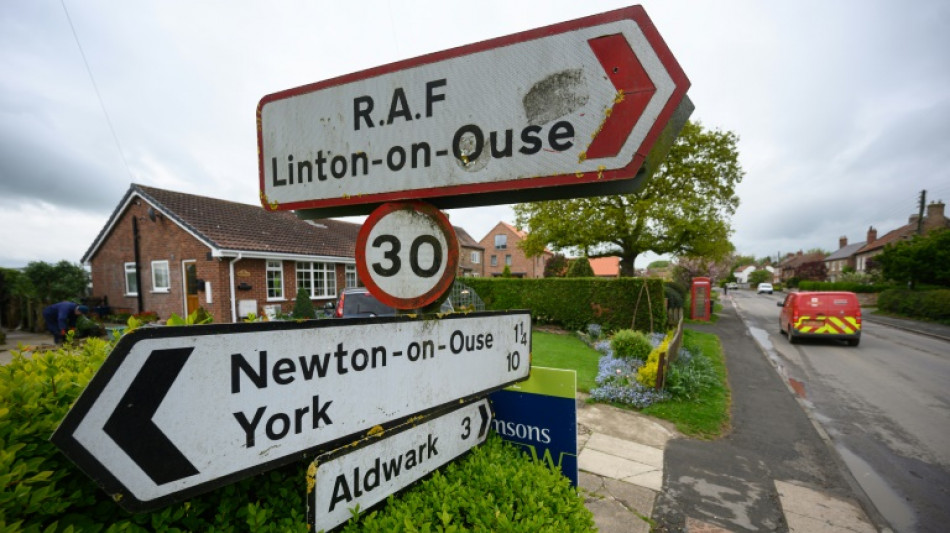
RBGPF
61.8400

The village of Linton-on-Ouse is usually a sleepy place, but its residents are up in arms at a UK government plan to house up to 1,500 asylum seekers, whose numbers will dwarf local residents.
In mid-April, 43-year-old Steve says he was walking his dog in the village in North Yorkshire when he learnt of the proposal from visiting reporters.
They "asked what I thought of what was going on" Steve tells AFP.
It was then he found out that ministers want to open a centre for male asylum seekers in the heart of the village, in northern England.
The project is based on a similar one in Greece, which has seen a wave of migrants crossing the Mediterranean Sea land on its islands.
It aims to help reduce the number of migrants crossing the Channel from northern France in small boats, which has soared to record highs in recent years despite government promises to tackle the issue post-Brexit.
According to the interior ministry the existing accommodation on a former Royal Air Force base which closed in 2020 "will help end the government's reliance on expensive hotels" where tens of thousands of asylum seekers live at a cost to taxpayers of £4.7 million ($5.8 million) per day.
"1,500 people in a village of 700 seems to have an absence of proportionality", argues Olga Matthias, another local.
– 'Lose-lose' –
While they say they back the idea of housing refugees in their village, Steve and Olga say they cannot understand why the Home Office chose to send such a large number to Linton-on-Ouse.
"There is nothing to do here," says Matthias, glancing down the deserted street with immaculate front gardens.
The pub closed a long time ago and the only shop does not sell much except newspapers.
There is a bus four times a day that goes to York, the nearest large city about 10 miles (16 kilometres) away, but the price of a return ticket at £6.50 is more than an asylum seeker's daily allowance of £5.66.
"It's a lose-lose scenario," says Steve. "They have a right for a peaceful life especially after the countries these people are coming from, so they have the right to be here."
He argues the village does not have the facilities to allow its population to more than triple.
The sewage system is already failing, there is no high-speed internet nor police presence, he lists.
One local, 19-year-old Mya Aston, says that for her, the prospect of 1,500 more men walking in the streets was "daunting".
Another voices concerns about how the plan might affect home prices, where the average detached house sells for nearly £350,000 ($435,000).
Furious at not being consulted, the villagers are now fighting to halt the project, even as the first asylum seekers are set to arrive.
The local Conservative MP, Kevin Hollinrake, says he is considering legal options.
– 'Nobody wants this' –
"Nobody wants this. Nobody. Not the far-rights, not the villagers, not refugee charities, only the Home Office wants this to happen," says Nicola David of Ripon City of Sanctuary, a group helping refugees.
The public debate has been dominated in recent weeks by a government proposal to send asylum seekers who arrive illegally to Rwanda.
But David argues that the opening of a reception centre in Linton-on-Ouse is far more problematic.
"The Rwanda (plan) was really shocking cause it's massive and it's bizarre. But the Refugee Council did some calculations and they reckon probably 200 people would get sent to Rwanda so that's actually quite small and there is a very strong chance it won't go ahead at all," says David.
In the case of Linton-on-Ouse, "this is happening right now and it's happening right here", says David, worried about the condition of planned accommodation, while the government has been vague about how the site will be managed.
She gives the example of Napier former military camp in Kent near the Channel coast, which has been used since 2020 to house asylum seekers, prompting criticism of the authorities over the squalid living conditions and migrants being held in semi-detention.
"They're constantly apologising and they're constantly (holding) public inquiries that cost a fortune... and now they think they can run (a centre) for 1,500 people... here?" David questions.
"What assurance does anybody have that it's not all going to go horribly wrong?", she asks. "And then what happens when it does?"
A.Senn--NZN